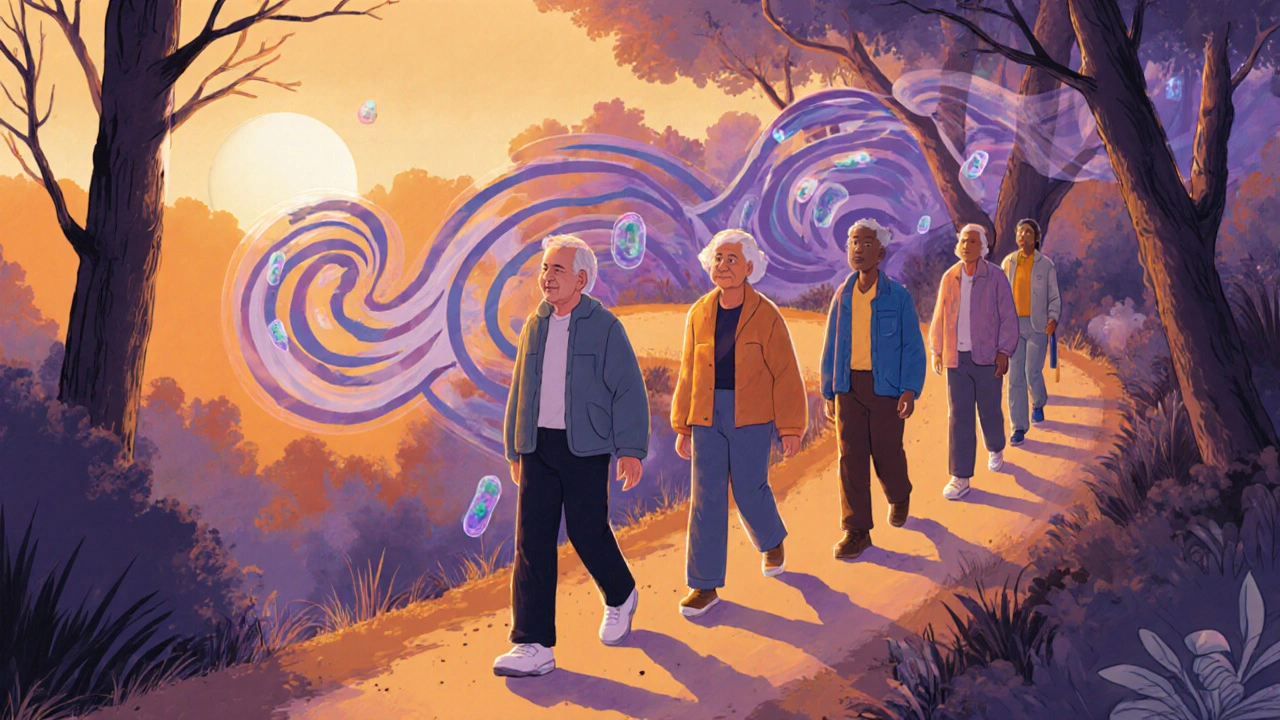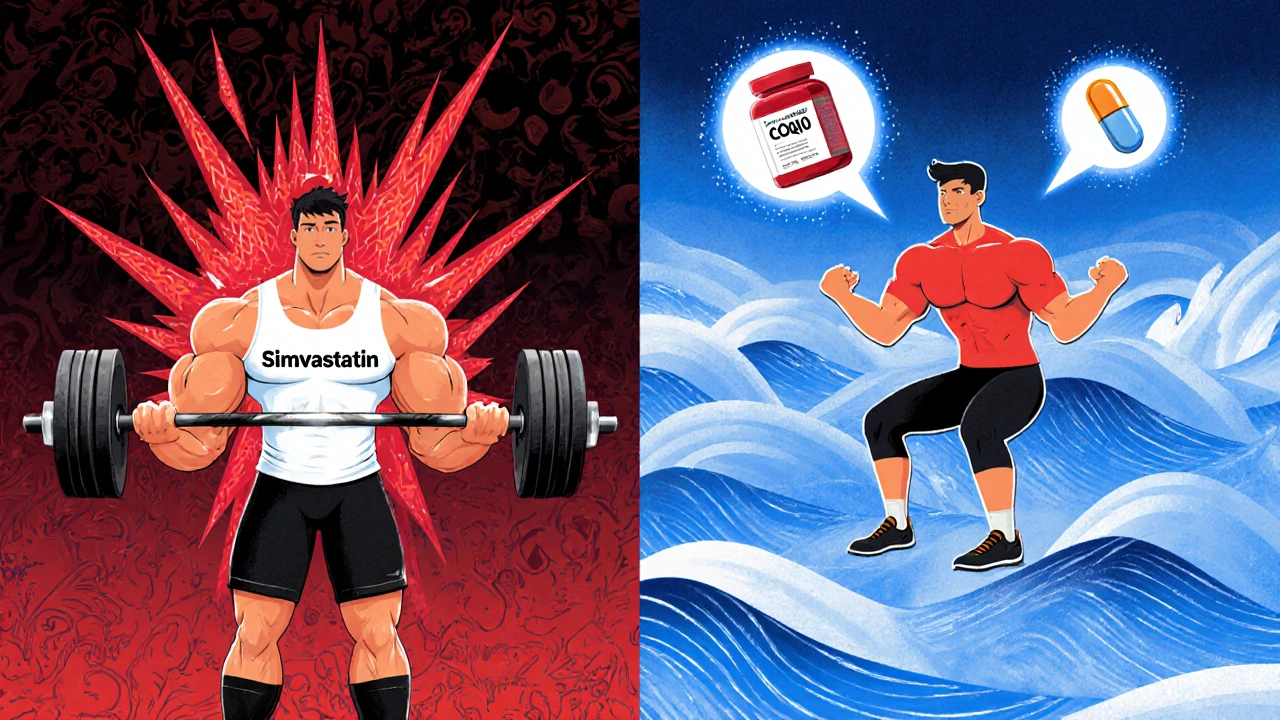
If you're taking statins and trying to stay active, you're not alone-and you're not broken. Millions of Americans on statins worry that working out will make their muscle pain worse. Some quit exercise altogether. Others push through the ache, fearing they’re damaging their muscles. The truth? It’s more complicated than that. And the science from 2023 and 2024 is finally giving us clear answers.
Statins and Muscle Pain: It’s Not Always the Drug
About 5 to 10% of people on statins report muscle pain, according to clinical trials. But real-world numbers? Up to 29%. That’s a big gap. Why? Because not all muscle soreness comes from the statin. Many people start statins around the same time they begin a new workout, gain weight, or age-three things that naturally cause aches. The pain shows up, they blame the pill, and they stop moving. But here’s what the data says: if you were already active before starting statins, you’re 37% less likely to develop muscle pain. That’s not a coincidence. Your muscles are already adapted. Your body knows how to recover.Exercise Doesn’t Make Statin Muscle Pain Worse-Most of the Time
A major 2023 study from Radboud University Medical Center looked at 105 people: 35 on statins with muscle pain, 35 on statins with no pain, and 35 not on statins. Everyone did 30 minutes of moderate cycling. Researchers measured creatine kinase (CK), a key marker of muscle damage. The results? No difference. Symptomatic statin users didn’t spike their CK levels more than the others. That’s huge. It means moderate exercise doesn’t add extra damage on top of what the statin might already be doing. Another study followed 100 people walking 30 to 50 kilometers a day for four days during the Nijmegen Marches. Both statin users and non-users saw their CK levels rise-from 150 U/L to about 350 U/L. Same increase. Same symptoms. Same recovery. That’s not just safe-it’s reassuring. Long, steady movement doesn’t trigger dangerous muscle breakdown in statin users.Where the Risk Really Lies: High-Intensity and Eccentric Exercise
Not all exercise is created equal. The problem isn’t walking, cycling, or swimming. It’s the stuff that tears muscle fibers hard and fast: heavy lifting, downhill running, jumping, and especially high-intensity interval training (HIIT). A 2016 study found that after eccentric exercise (like lowering a weight slowly), statin users saw CK levels jump 300%. Non-users? Only 200%. That’s a 50% bigger spike. And in the Boston Marathon study from 2007, statin users had CK levels nearly 50% higher than non-users after 26.2 miles. One runner, Maria Rodriguez, ended up in the hospital with CK levels of 12,450 U/L-normal is under 200. She had rhabdomyolysis. That’s rare, but it happened because she was on high-dose simvastatin and pushing through brutal training. If you’re on statins and love HIIT, CrossFit, or heavy weightlifting, you’re at higher risk. Not because statins are evil. But because they can weaken your muscles’ energy system. Statins reduce CoQ10 by 40% within a month. CoQ10 helps your mitochondria make energy. Less energy means less resilience under stress. So when you go all-out, your muscles fatigue faster and break down more easily.
Not All Statins Are Created Equal Either
The type of statin you take matters a lot. Lipophilic statins-atorvastatin, simvastatin, lovastatin-slide easily into muscle cells. Hydrophilic ones-pravastatin, rosuvastatin-don’t. That’s why atorvastatin 80 mg carries a 10.5-times higher risk of muscle injury than pravastatin 40 mg, according to FDA data. A 2013 study showed that people on simvastatin improved their VO2 max (a measure of fitness) 6.9% less than those on placebo after 12 weeks of training. Their bodies just couldn’t adapt as well. But rosuvastatin? No difference. In fact, marathoner John Davis switched from atorvastatin 40 mg to rosuvastatin 20 mg and kept running 40 miles a week-no pain, no drop in performance. If you’re struggling with muscle pain, talk to your doctor about switching. The success rate for symptom relief when switching to a hydrophilic statin? Around 65%.What to Do If You Have Muscle Pain
Don’t stop moving. But do adjust. Start with walking. 10 to 15 minutes a day, at a pace where you can talk but not sing. That’s about 3 to 4 METs. Gradually add 5 minutes each week. Most people see improvement within 4 to 6 weeks. The Mayo Clinic recommends checking your CK level before you start and again 24 to 48 hours after your first moderate workout. If it’s over 1,000 U/L, pause and check in with your doctor. Here’s how to tell if it’s the statin or the exercise:- Statin pain: Comes on within 30 days of starting the drug. Feels like constant soreness, even on rest days. Often in shoulders, thighs, or calves.
- Exercise pain: Shows up after a specific workout. Gets better with rest. Feels like normal post-workout soreness that fades in 2 to 3 days.

What Works: Proven Strategies to Keep Moving
People who keep exercising on statins don’t just have luck-they have a plan. Here’s what actually helps:- Switch statins: Try pravastatin or rosuvastatin. Success rate: 65%.
- Lower the dose: Take your statin every other day. Success rate: 58%.
- Start slow: Build up exercise gradually. Success rate: 72%.
- Take CoQ10: 200 mg daily. A 2023 meta-analysis found it helps reduce muscle pain in about half of users.
- Avoid HIIT and heavy eccentric lifts: Replace them with steady cardio and bodyweight circuits.
What’s Next? Personalized Plans Are Coming
The future is getting smarter. Researchers have found that a gene called SLCO1B1 makes some people 2.3 times more likely to get muscle pain from statins during exercise. A blood test for this gene could soon tell you whether you’re at high risk. The Statin-Exercise Interaction Registry (SEIR) is tracking 10,000 people across the U.S. to map out patterns. Early data suggests that people who stick with moderate exercise while adjusting their statin have a 78% success rate in staying pain-free and active. By 2026, 45 million Americans will be on statins. That’s nearly 1 in 6 adults. If we tell them to stop exercising because of muscle pain, we’re trading heart protection for fitness loss. And that’s a bad deal. The goal isn’t to avoid statins or avoid exercise. It’s to find the right balance-for your body, your meds, and your life.Can I still exercise if I have statin-related muscle pain?
Yes, but you need to adjust. Moderate exercise like walking, cycling, or swimming is safe and even helpful. Avoid high-intensity workouts, heavy lifting, and downhill running until your pain improves. Start slow-10 to 15 minutes a day-and build up gradually. Most people find relief within weeks by combining gentle movement with a statin switch or dose change.
Do statins ruin the benefits of exercise?
They can, but not always. Some statins, especially high-dose lipophilic ones like simvastatin and atorvastatin, reduce your body’s ability to improve fitness by blunting mitochondrial function. Studies show up to a 7% drop in VO2 max gains. But hydrophilic statins like rosuvastatin and pravastatin don’t have this effect. If you’re training for performance, switching statins may restore your progress.
Is CoQ10 supplementation worth it for statin users?
For many, yes. Statins lower CoQ10 by 40%, which can reduce muscle energy production. Taking 200 mg daily has been shown in multiple studies to reduce muscle pain in about half of users. It’s not a magic fix, but it’s low-risk and often helpful-especially when combined with moderate exercise and a statin switch.
Which statin causes the least muscle pain with exercise?
Hydrophilic statins like rosuvastatin and pravastatin cause far less muscle pain than lipophilic ones like atorvastatin and simvastatin. Rosuvastatin is often the top choice because it’s effective at lowering cholesterol and has minimal muscle penetration. In clinical practice, switching to rosuvastatin helps 65% of people with statin-related muscle symptoms.
When should I stop exercising because of muscle pain?
Stop if your pain is severe, sudden, or accompanied by dark urine, weakness, or swelling. Also, pause if your creatine kinase (CK) level rises above 1,000 U/L after exercise. That’s five times the upper limit of normal and could signal early rhabdomyolysis. Get tested, talk to your doctor, and don’t rush back. But don’t stop entirely-switch to gentle movement and work with your provider to find a safe plan.


Just switched from atorvastatin to rosuvastatin last month and I’m cycling 40 miles a week now without a single ache. Seriously, if you’re suffering, talk to your doc about switching. It’s not magic-it’s chemistry.
Started walking 15 minutes a day after my statin was prescribed. At first I thought it was the pill-but turns out my body just needed to relearn how to move. Four weeks in and I’m up to 30 minutes. No CoQ10, no drama. Just slow and steady. You got this.
Let me tell you-stopping exercise because of statin pain is like throwing out your baby with the bathwater. I used to do CrossFit on simvastatin and ended up in the ER with CK levels through the roof. Switched to rosuvastatin, dropped the HIIT, started swimming and walking. Now I’m stronger than ever. Statins don’t ruin fitness-they just need a smarter partner.
I’ve been on pravastatin for five years, walk 5km daily, and have never experienced muscle pain. The key is consistency and avoiding eccentric overload. The data is clear: moderate activity is not only safe-it’s protective. Don’t let fear dictate your movement.
The distinction between lipophilic and hydrophilic statins is clinically significant but underappreciated in primary care settings. The pharmacokinetic profile of rosuvastatin and pravastatin results in significantly reduced myocyte penetration, thereby mitigating the risk of statin-associated muscle symptoms during physical exertion. This is not anecdotal-it is evidenced by multiple randomized controlled trials and meta-analyses.
bro u all overthinkin this. statin = bad for muscles. just dont take it. i been running 100km a week on no meds and my cholesterol is fine. america overmedicating everything
Actually, the 2023 Radboud study had a small sample size and lacked long-term follow-up. Also, the CK levels cited are not always clinically relevant. Many patients experience symptoms without elevated CK. The assumption that exercise is universally safe is premature.
So you’re telling me I should just switch statins and keep going? What about the fact that my doctor said my cholesterol is too high to risk lowering the dose? I’ve been on atorvastatin for three years, I can barely lift my arms, and now you want me to just walk more? That’s not advice-that’s gaslighting.
My uncle took statins, stopped exercising, got fat, had a heart attack. Now he’s on pravastatin and walks every morning. He’s 72. Still alive. That’s the real science. You don’t quit movement-you adapt. America’s weak.